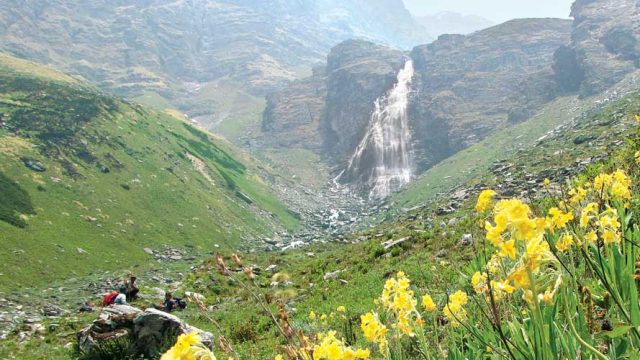Imagine, if in the course of a trek in a pristine part of the country, you dropped two toffee wrappers and your partner left a bit of toilet paper on the trail, your guide set up a campfire each night and your kids collected a small fossil or rock each. Now, suppose that this trail attracts a hundred small groups every year that behave exactly the same manner as your group. And you return to trek on this very trail after 10 years, would you find the environs as pristine? Before you grumble to your friends about the devastation, remember two of the 2,000 toffee wrappers littered on the track were yours. No matter how small the offence seems, it all adds up. So, do remember to leave nothing but your footprints.
Tips To Follow On Your Trek
- Travel in groups of not more than four. Larger groups make a larger mess. If in a large group, walk in a single file on the track rather than abreast to avoid trampling on flowers and ferns.
- Don’t make a noise The great Indian holiday often means blaring music and lots of screaming and shouting. Remember, you left the city to experience something different. Listen to the wind and the rustling of leaves instead. Others on the trail will thank you.
- Respect wildlife View birds and animals from a distance. Animals find quick movements and loud noises stressful. If you scare them, they will tend to avoid that area, spoiling it for animal lovers.

- Leave areas as you found them Camp, wherever possible, at campsites used by others instead of trying to clear the ground for a new campsite.
- Save trees Make no open campfires and discourage others from doing so. Where water is heated by scarce firewood, use as little of it as possible. Choose kerosene or other fuel-efficient stoves.
- Avoid carrying canned food Don’t leave tins behind. Leave campsites clean and remember to take back all non-biodegradable litter to the road head/ towns for proper disposal. Bury only bio-degradable food waste.
- Human waste disposal Insist that the trekking agent carry a toilet tent if you are in a large group. A dry pit toilet of at least eight inches should be dug, filled with soil and covered with rocks once you are ready to leave the campsite. If there are only a couple of you, then find a place at least 200ft away from rivers and other water sources. Use water rather than toilet paper to clean up. You can urinate anywhere as it has little impact on soil or vegetation.
- Tampons and sanitary napkins Proper disposal of tampons and napkins requires that they be placed in plastic bags and taken out. Do not bury them because they don’t decompose readily and animals may dig them up.
- Do not use detergents/ soaps at water sources. Carry water away from the source to wash up. Better still, use mud from the river to clean pots and pans. Fallen leaves may be used as a scrub.
- Do not pluck flowers or take cuttings, seeds and roots of plants. ■
With inputs from Mandip Singh Soin

Snow trivia – it’s warmer below
If you looked across a snow-covered area in winter, where would you think the ground would be warmer: in open areas where the snow has blown away or beneath the snow? Believe it or not, it’s warmer beneath the snow, which acts as insulation, protecting plants by keeping the temperature around 0°C.
Can you guess how long it will take for these things to biodegrade?
Banana peel 3–4 weeks
Paper bag 1 month
Plastic bag 1 million years
Cotton rag 5 months
Woollen sock 1 year
Aluminium can 200–500 years
Leather shoe 40–50 years
Styrofoam cup Eternity
Tin can 50–100 years
Wood 10–15 years

Trivia on India’s Biodiversity
India occupies 2.4 per cent of the Earth’s landmass but has over 8 per cent of the world’s known wildlife.
- The Eastern Himalayas are endemic to 3,500 species of higher plants, 20 species of reptiles, 25 endemic species of amphibians and a very rich fauna of insects.
- Of the eight species of turtles in the world, India is home to five species.
- Among the 20,000 species of fish known, more than 2,000 species are found in India.
- Of the 15,000 flowering plant species in India, over 4,500 are to be found in the Western Ghats.
Different species found in India
- Algae 5,000 ● Bacteria 850 ● Fungi 1,25,000 ● Molluscs 5,000
- Invertebrates 20,000 ● Insects 59,353 ● Fish 2,546 ● Amphibians 216 ● Reptiles 484 ● Mammals 417 ● Birds 1,232
India’s biodiversity is a national heritage, as valuable as the Taj Mahal. As different species of plants and animals interact in complex ways to sustain life on earth, destruction of the biodiversity will also cause destruction of our planet. Maldives, for example, had sufferred significantly less damage from tsunamis as compared to other islands as its vast, protected coral reefs had absorbed their impact. But, on the other hand, unchecked atmospheric pollution that is increasing global warming, is causing glaciers to melt. If glaciers, which are the source of water, disappear, what will happen to life on Earth?




